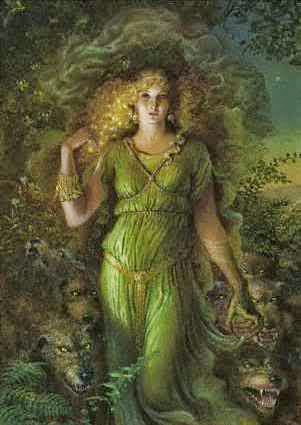The Celtic Mythology of Germany, Great Britain, Scandinavia, and the other Northern Nations
The Celtic mythology of Germany, Great Britain, Scandinavia, and the other northern nations is as extraordinary as that of Greece and Rome. Every race and nation under the heavens were at one time steeped in superstition to such an extent as to make people, living in enlightened ages, wonder that creatures endowed with reasoning powers should ever have given themselves over to such vile delusions as some of our forefathers seem to have
The Celtic mythology of Germany, Great Britain, Scandinavia, and the other northern nations is as extraordinary as that of Greece and Rome. Every race and nation under the heavens were at one time steeped in superstition to such an extent as to make people, living in enlightened ages, wonder that creatures endowed with reasoning powers should ever have given themselves over to such vile delusions as some of our forefathers seem to have
[Pg 86] done. The adventures of the Scandinavian gods, giants, and elves were not behind those of the gods and supernatural beings in the south and east. In the beginning of time, we are informed, a world existed in the north called Niflheim, in the centre of which was a well from which sprang twelve rivers. In the south was another world, Muspelheim—a light, warm, radiant world, the boundary of which was guarded by Surt with a flaming sword. From Niflheim flowed cold streams called Elivaager, which, hardening into ice, formed one icy layer upon the other, within the abyss of abysses that faced the north. From the south there streamed forth the sparkling heat of Muspelheim; and as the heat and cold met, the melting ice-drops became possessed of life, and produced, through the power of him who had sent forth heat, Ymir, the sire of the frost giants. Ymir obtained his nourishment from four milky streams that escaped from the udders of the cow Aedhumla—a creature formed from the melting frost. From Ymir there came forth offspring while he slept, viz. a man and woman, who emerged from under his left arm, and sons from his feet. Thus was produced the race of the frost giants. Meantime, as the cow Aedhumla licked the frost-covered stones, there came forth the first day a man's hair, a head the second day, and a man, complete in all his parts, the third day. This man, Buri, had a son named Bor, who married Beltsa, one of the giant race, by whom he had three sons, Odin, Vili, and Ve.
Odin became the chief god, and ruled heaven and earth, and was omniscient. As ruler of heaven, his seat was Valaskjalf, from whence he sent two black ravens, daily, to gather tidings of all that was being done throughout the world. As god of war, he held his court in Valhalla, whither brave warriors went after death to revel in the tumultuous joys in which they took pleasure when on earth. Odin had different names and characters, as many[Pg 87] of the gods had. By drinking from Mimir's fountain, he became the wisest of gods and men. He was the greatest of sorcerers, and imparted a knowledge of his wondrous art to his favourites. Frigga was his queen, and the mother of Baldur, the Scandinavian Apollo; but he had other wives and favourites, and a numerous progeny of sons and daughters. All over Scandinavian lands, but particularly in Denmark, the people imagine that they hear his voice in the storm.
The other two brothers were less famous, but they were gods, and assisted Odin to slay Ymir, and carry his body into the middle of Ginnungagap, and formed from it the earth and heavens. Of his blood the brothers made all the seas and waters, taking the gore that flowed from his body to form the impassable ocean which is supposed to encircle the earth. Of his bones they made the mountains, using the broken splinters and his teeth for the stones and pebbles. From his skull they made the heavens, at each of the four corners of which was stationed a dwarf, of whom we shall hear more by-and-bye. Of Ymir's brains clouds were formed, of his hair plants and herbs, and of his eyebrows a wall of defence was made against the giants round Midgard, the central garden or place of abode of the sons of men. The work of the celebrated brothers was not ended by these achievements; for they took the sparks that were cast out of the world Muspelheim, and, throwing them over the face of the heavens, produced the sun, moon, stars, and fiery meteors, and so arranged them in their places and courses, that days, months, and years followed. Allfader placed chariots and horses in heaven, where Night rode round the earth with her horse Hrimfaxi, from whose bit fell the rime-drops that every morning bedewed the earth. After her course followed her son Day, with his horse Skinfaxi, from whose shining mane light beamed. Mani directed the course of the moon, and Sol drove the chariot of the sun. They[Pg 88] were followed by a wolf, which was of the giant race, and that will in the end of time swallow, or assist to swallow, up the moon, darken the sun's brightness, let loose the boisterous winds, and drink the blood of every dying man.














